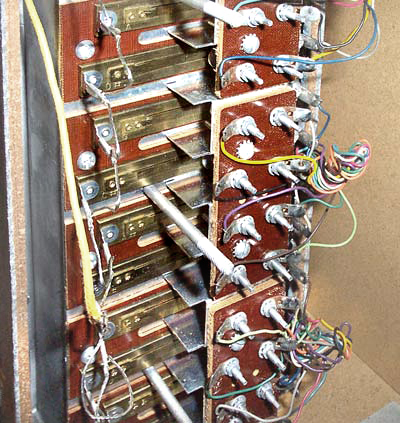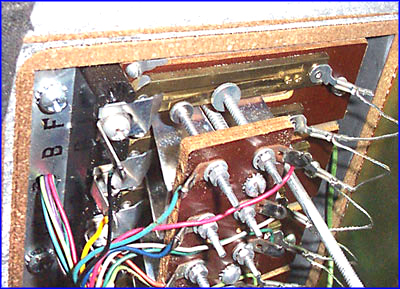Wurlitzer 4600 series
North Suburban Hammond Organ Service

Above. This is the interior of the pan for the second octave of reeds which shows the two pickups above each reed. There is also a flat sheet metal pickup at the front edge of each reed.
In these particular 4600 series instruments, some reed pans have three pickups per reed instead of two. This is so that the pedal tones may be independent of the lower pitches on the keyboards and not be borrowed, so that when you play a pedal, if you're already holding a lower note on one of the keyboards, you will still hear the pedal note come in, which would not happen if it were borrowed from the same pickups that provide the keyboard tones. This also allows the pedal tones to have less harmonic development, because the pedal tone pickups are both larger and also closer to the centers of the reeds.
On at least some of the spinet versions of these instruments, the pedal was derived from the tones available on the keyboards, and there was no 16' or first octave of reeds. In the early version of these instruments, the center pickups provided a softer flute tone for the accompaniment. Later versions, including these 4600 series consoles provided a soft flute tone for the accompaniment by applying a reduced voltage to the normal flute tone pickups over the ends of the reeds.
These pictures and those on the preceding pages give you a very good look at the Wurlitzer electrostatic tone generating system where the vibrating reeds act as variable capacitors to generate AC audio waveforms. The pickups above the reeds can be screwed in or out to move them closer or farther from the reeds which adjusts the level of each note, so that when the instrument was initially being set up at the factory, it would be possible to scale the output levels of each note for best overall sounding results. The front edge pickups mount on a black plastic block. The pickups themselves are slotted and can be moved closer to or farther away from the front edges of their respective reeds. In order to generate waveforms with significant harmonic development, it is necessary for the front edge pickups to be very close to the reeds. It appears from what checking that I have done that this distance is within a few thousandths of an inch.
If a reed should accidentally touch a pickup, the result is a loud bang over the speakers, and if the reed repeatedly hits a pickup as it vibrates, the result is loud, useless distorted noise that will completely overpower any possible musical signals. Just how sensitive is this electrostatic pickup system?
Below. Closeup of a three-pickup reed. This is the third octave of reeds which generates notes beginning with tenor C through the next B. The larger pickup over the center of the reed is for a pedal note. In addition to the two above the reed, there is also the flat sheet metal pickup at the front edge of each reed which is clearly visible in the picture and held in place by a Phillips head screw. This picture was taken with the instrument in operation. Notice that the top reed in the pictures is at the outward end of its vibration. At rest it would lie flat with the shallot.

I had just reassembled a customer's Wurlitzer reed unit after backing one pickup away from its associated reed because the note on the keyboard from that pickup was somewhat louder than the other adjacent notes. When I turned on the instrument, there was a continuous loud, random crackling buzz along with the reed's pitch whenever I played that key. After disassembling the unit again and checking carefully, I found a cat hair that was stuck on the reed pickup and was randomly touching the reed! So the single cat hair itself was sufficiently conductive to make a partial short circuit whenever it touched the reed. The instrument owner's cat had been investigating the reed unit out of the natural curiosity that cats seem to have, and evidently one of his hairs got pulled into the unit as I had it operating with the appropriate pan removed. When you run one of these reed units with a pan removed, the slighlty negative pressure below the reeds will make air flow into the reeds and if any light particles of dust or hairs are floating around nearby, they will get drawn in with the air.
When the pan is in place of course, then the air enters the pan through the adjustable blast gate and the pan pressure is slightly higher than that below the reeds. With a pan removed, the entire airflow pattern is a little different, but the reeds will still operate which is helpful for making adjustments while watching either a meter or a scope. Anyhow, removal of the cat hair corrected this problem. I mention this because it demonstrates very well just how sensitive the electrostatic reed system is to dust an dirt and why it's necessary to have the reed pans properly seated on their gaskets and bolted in place.
Typically, the DC voltage that is applied to the appropriate pickups by the contacts under the playing keys is +160 VDC. Some additional tonal effects are available by keying the pickups with a greatly reduced voltage which then decreases the amplitude of the resulting signal. If the DC is suddenly applied to the pickups, the tones would begin with a fairly loud pop. Therefore, it is necessary to apply the keying voltage through small resistor-capacitor networks which delay the voltage rise-time on the pickups. Even when on the fast percussive mode, there is still a few milliseconds' worth of buildup to prevent noisy keying transients. On the next page we will look at the keying system to see how the DC voltage from the keys and pedals of the instrument gets to the appropriate pickups on the reeds.
Previous Page Page 10. next Page